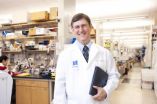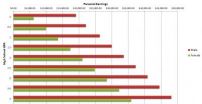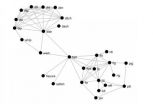(Press-News.org) SALT LAKE CITY— In the body, a skin cell will always be skin, and a heart cell will always be heart. But in the first hours of life, cells in the nascent embryo become totipotent: they have the incredible flexibility to mature into skin, heart, gut, or any type of cell.
It was long assumed that the joining of egg and sperm launched a dramatic change in how and which genes were expressed. Instead, new research shows that totipotency is a step-wise process, manifesting as early as in precursors to sperm, called adult germline stem cells (AGSCs), which reside in the testes.
The study was co-led by Bradley Cairns, Ph.D., University of Utah professor of oncological sciences, and Huntsman Cancer Institute investigator, and Ernesto Guccione, Ph.D., of the Agency for Science Technology and Research in Singapore. They worked closely with first author and Huntsman Cancer Institute postdoctoral fellow, Saher Sue Hammond, Ph.D. The research was published online in the journal Cell Stem Cell.
Typically, sperm precursors live a mundane life. They divide, making more cells like themselves, until they receive the signal instructing them to mature into sperm.
There is evidence, however, that these cells have the potential to do more. Under the unusual conditions that promote the cells to form dense cancerous masses called testicular teratomas, the young sperm transform into precursors of skin, muscle, and gut.
This realization prompted the investigators to examine the gene program within sperm precursors. They wondered, would it be like that of a cell that is destined to become a single cell type, or like that of a cell with the potential to become anything?
The answer, they found, is that the sperm precursors are somewhere in between. The most telling evidence is the status of a quartet of genes: Lefty, Sox2, Nanog, and Prdm14. When activated, the genes can trigger a cascade of events that give cells stem cell properties. In cells limited to becoming one cell type, the genes are silent.
Yet in sperm precursors, the genes bear a code of chemical tags, called methylation groups, indicating that the four genes are silenced, but poised to become active. In other words, embedded within these cells, is the potential to become totipotent.
Cairns compares the tags on the poised genes to bookmarks. "Sperm cells and their precursors put 'bookmarks' at all the important genes they need to access quickly." Once fertilization occurs, he explains, cells have to become fully totipotent in a short amount of time. "Then, when the sperm and egg come together, all you have to do is complete the job that you had already started."
The engineering principal, as he calls it, ensures the transition occurs rapidly and accurately.
The result is just one of many that together comprise a detailed playbook documenting genetic and epigenetic changes that take place along the journey to becoming totipotent. The rich resource will guide future studies toward a deeper understanding of totipotency, cancer, and fertilization.
INFORMATION:
About Huntsman Cancer Institute at the University of Utah
Huntsman Cancer Institute (HCI) is one of the world's top academic research and cancer treatment centers. HCI manages the Utah Population Database - the largest genetic database in the world, with more than 16 million records linked to genealogies, health records, and vital statistics. Using this data, HCI researchers have identified cancer-causing genes, including the genes responsible for melanoma, colon and breast cancer, and paraganglioma. HCI is a member of the National Comprehensive Cancer Network (a 25-member alliance of the world's leading cancer centers) and is a National Cancer Institute-Designated Cancer Center. HCI treats patients with all forms of cancer and operates several high-risk clinics that focus on melanoma and breast, colon, and pancreas cancers. The HCI Cancer Learning Center for patient and public education contains one of the nation's largest collections of cancer-related publications. The institute is named after Jon M. Huntsman, Sr., a Utah philanthropist, industrialist, and cancer survivor.
The young sperm, poised for greatness
University of Utah, Huntsman Cancer Institute scientists uncover early steps of totipotency in sperm precursors
2014-05-19
ELSE PRESS RELEASES FROM THIS DATE:
'Smoking gun' evidence for theory that Saturn's collapsing magnetic tail causes auroras
2014-05-19
University of Leicester researchers have captured stunning images of Saturn's auroras as the planet's magnetic field is battered by charged particles from the Sun.
The team's findings provide a "smoking gun" for the theory that Saturn's auroral displays are often caused by the dramatic collapse of its "magnetic tail".
Just like comets, planets such as Saturn and the Earth have a "tail" – known as the magnetotail – that is made up of electrified gas from the Sun and flows out in the planet's wake.
When a particularly strong burst of particles from the Sun hits Saturn, ...
Solar energy prospects are bright for Scotland, experts say
2014-05-19
Installing state-of-the-art solar panels on a quarter of a million roofs could meet one-sixth of Scotland's electricity demands, experts say.
Scientists say the strategy could ease the plight of one in three Scottish households, which currently struggle to provide themselves with adequate heat and hot water.
Researchers, business leaders and public sector experts have contributed to a report which sets out how Scotland could benefit from solar power.
They say harnessing energy from the sun on the roofs of south-facing buildings could have significant economic, ...
Antarctica's ice losses on the rise
2014-05-19
Three years of observations show that the Antarctic ice sheet is now losing 159 billion tonnes of ice each year – twice as much as when it was last surveyed.
A team of scientists from the UK Centre for Polar Observation and Modelling, led by researchers at the University of Leeds, have produced the first complete assessment of Antarctic ice sheet elevation change.
They used measurements collected by the European Space Agency's CryoSat-2 satellite mission, which carries an altimeter specially designed for this task.
In sharp contrast to past altimeter missions, CryoSat-2 ...
Sanofi Pasteur announces favorable Phase II data for investigational C. difficile vaccine
2014-05-19
Boston, United States of America – May 19, 2014 – Sanofi Pasteur, the vaccines division of Sanofi (EURONEXT: SAN and NYSE: SNY), presented Phase II (H-030-012) trial results for an investigational vaccine for the prevention of Clostridium difficile (C. diff) infection (CDI) at the 114th General Meeting of the American Society for Microbiology (ASM). The Phase II trial met its primary objectives, reactions were generally mild and of short duration, and the candidate vaccine generated an immune response against C. diff toxins A and B. These toxins are largely responsible ...
Your high school GPA could affect your income
2014-05-19
Coral Gables, Fla. (May 19, 2014)—A team of researchers led by Michael T. French, professor of health economics at the University of Miami (UM), finds that high school grade point average (GPA) is a strong predictor of future earnings.
The findings, published recently in the Eastern Economic Journal, show that a one-point increase in high school GPA raises annual earnings in adulthood by around 12 percent for men and 14 percent for women.
Although previous studies have found a relationship between higher levels of education and greater earnings, less is known about ...
Keywords hold vocabulary together in memory
2014-05-19
Much like key players in social networks, University of Kansas scientists have found evidence that there are keywords in word networks that hold together groups of words in our memory.
In a study published in the Journal of Memory and Language, Michael Vitevitch, KU professor of psychology, showed that research participants recognized these keywords more quickly and accurately than other words that were like the keywords in many respects except for their position in a network of 20,000 similar-sounding English words that he and colleagues created in 2008.
"If words ...
National heart organizations join to combat the global hypertension epidemic
2014-05-19
NEW YORK, N.Y., May 19, 2014: It's estimated that more than 970 million people have hypertension1 and, globally, the disease is responsible for more than nine million deaths every year, making it one of the leading causes of death worldwide. In an effort to help manage the epidemic, leading scientists from the American Society of Hypertension (ASH), American Heart Association (AHA) and the Centers for Disease Control and Prevention (CDC) convened a joint panel to discuss a global project aiming to improve the treatment and control of hypertension worldwide.
The joint ...
IN-TIME shows equal benefit of home telemonitoring in ICD and CRT-D patients
2014-05-19
Athens, 19 May 2014: Home telemonitoring is equally effective in ICD and CRT-D patients, a subanalysis of the IN-TIME trial has shown. The findings were presented for the first time today at the Heart Failure Congress 2014, held 17-20 May in Athens, Greece. The Congress is the main annual meeting of the Heart Failure Association of the European Society of Cardiology.
The prospective IN-TIME multicentre trial included 664 patients with chronic heart failure, class II or III New York Heart Association (NYHA) symptoms and left ventricular ejection fraction END ...
Novel device successfully treats central sleep apnea in heart failure
2014-05-19
Athens, 19 May 2014: A novel device implanted under the skin like a pacemaker successfully treats central sleep apnoea (CSA) in heart failure patients, according to research presented today at the Heart Failure Congress 2014, held 17-20 May in Athens, Greece. The Congress is the main annual meeting of the Heart Failure Association of the European Society of Cardiology.
The one year results of the remede® system pilot study were revealed for the first time by lead author Professor William T. Abraham from the Ohio State University. He said: "The remede® system is the first ...
Solution to helping teens with chronic disease may be at fingertips
2014-05-19
Adolescents with chronic diseases (ACD), such as cystic fibrosis, gastrointestinal disorders (including Crohn's disease) and Type 1 diabetes, often find the transition of managing their health care needs into adulthood to be challenging. Preparations for this transition are often clinic-based, costly and do not fully or effectively engage with this patient population. A new study by researchers at the University of California, San Diego School of Medicine found the answer to developing independent, self-management skills in ACD could be right at the patient's fingertips. ...
LAST 30 PRESS RELEASES:
Air pollution exposure and birth weight
Obstructive sleep apnea risk and mental health conditions among older adults
How talking slows eye movements behind the wheel
The Ceramic Society of Japan’s Oxoate Ceramics Research Association launches new international book project
Heart-brain connection: international study reveals the role of the vagus nerve in keeping the heart young
Researchers identify Rb1 as a predictive biomarker for a new therapeutic strategy in some breast cancers
Survey reveals ethical gaps slowing AI adoption in pediatric surgery
Stimulant ADHD medications work differently than thought
AI overestimates how smart people are, according to HSE economists
HSE researchers create genome-wide map of quadruplexes
Scientists boost cell "powerhouses" to burn more calories
Automatic label checking: The missing step in making reliable medical AI
Low daily alcohol intake linked to 50% heightened mouth cancer risk in India
American Meteorological Society announces Rick Spinrad as 2026 President-Elect
Biomass-based carbon capture spotlighted in newly released global climate webinar recording
Illuminating invisible nano pollutants: advanced bioimaging tracks the full journey of emerging nanoscale contaminants in living systems
How does age affect recovery from spinal cord injury?
Novel AI tool offers prognosis for patients with head and neck cancer
Fathers’ microplastic exposure tied to their children’s metabolic problems
Research validates laboratory model for studying high-grade serous ovarian cancer
SIR 2026 delivers transformative breakthroughs in minimally invasive medicine to improve patient care
Stem Cell Reports most downloaded papers of 2025 highlight the breadth and impact of stem cell research
Oxford-led study estimates NHS spends around 3% of its primary and secondary care budget on the health impacts of heat and cold in England
A researcher’s long quest leads to a smart composite breakthrough
Urban wild bees act as “microbial sensors” of city health.
New study finds where you live affects recovery after a hip fracture
Forecasting the impact of fully automated vehicle adoption on US road traffic injuries
Alcohol-related hospitalizations from 2016 to 2022
Semaglutide and hospitalizations in patients with obesity and established cardiovascular disease
Researchers ‘listen in’ to embryo-mother interactions during implantation using a culture system replicating the womb lining
[Press-News.org] The young sperm, poised for greatnessUniversity of Utah, Huntsman Cancer Institute scientists uncover early steps of totipotency in sperm precursors



